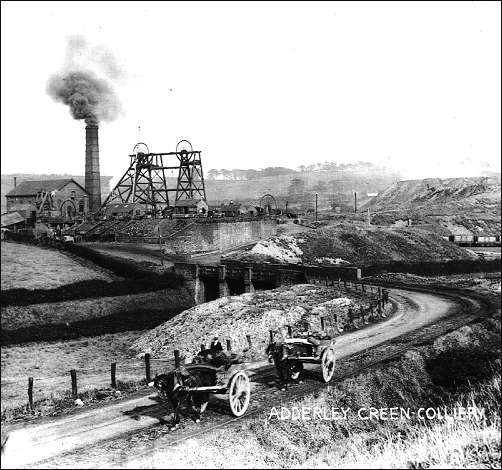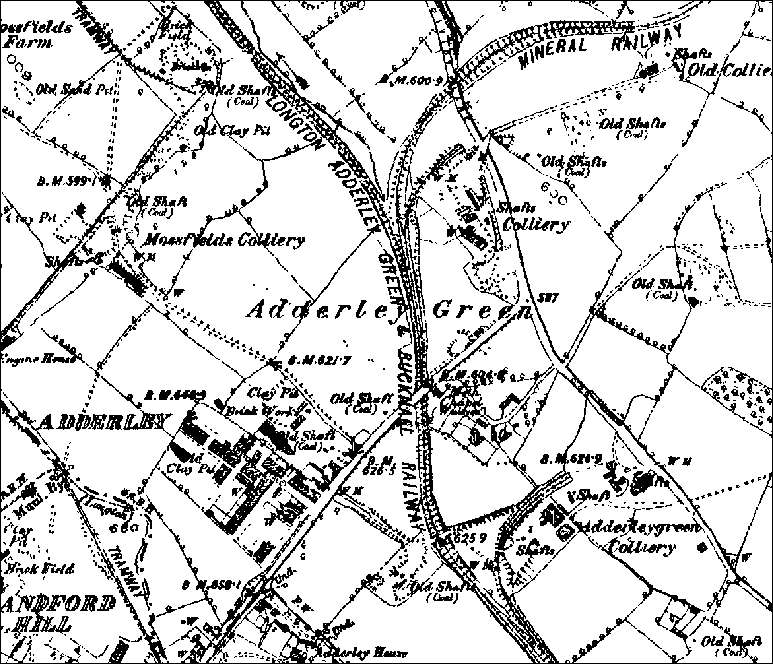|
Accident : July 1860
instantaneous death of five
workmen
William Hulme, age 40 yrs of
Wood's Lane Longton,
Jesse Hurst, age 45 yrs, of Adderly Green,
William Taylor, age 14 yrs of
Sutherland Rd. Longton,
Daniel Salmon, age 35 yrs East Vale Longton,
Enoch Wooley, age 18 yrs East Vale Longton
Miners Killed:
A most lamentable
accident occurred on Tuesday morning at the Adderley Green Colliery
near Longton North Staffs belonging to Stirrup and Pye, which
occasioned the almost instantaneous death of five of the unfortunate
workmen. The names of the deceased are: William Hulme, age 40 yrs of
Wood's Lane Longton, Jesse Hurst, age 45 yrs, of Adderly Green, William Taylor, age 14 yrs of
Sutherland Rd. Longton, Daniel Salmon, age 35 yrs East Vale Longton,
Enoch Wooley, age 18 yrs of the same place. Hurst was a widower and
left five children, Hulme a wife but no children and Salmon a wife
and two children.
Getting
coal from 'Hard Mine':
The pit is about 214 yards deep and
two beds of coal are being obtained out of what is known as the
Meadow Pit. The inset or crut of the "Hard-mine" being at the depth
of 130 yards down the shaft, whilst what is termed the "Banbury
coal" lies at the lower level at 214 yards. When coal has to be
drawn from the Hard-mine a scaffold is placed over the lower portion
of the shaft.
Rail fell
through scaffolding:
On Monday night the drawing was from
the Hard-mine and it appears that some where about midnight one of
the metal rails placed on the scaffold to convey the loaded wagons
so as to be drawn up, fell through an open aperture between the
scaffold and the brickwork of the shaft, and as it turns out, lodged
in an oblique position 25 yards from the bottom and thus formed an
unsuspected but effectual barrier to the free descent to the bottom
of the pit.
About 5.30 a.m. on Tuesday morning
the scaffold was removed for the purpose of drawing from the lower
level and the five individuals named above entered the cage.
A colliery rule required that the empty cage be lowered and drawn up
before any of the workmen are permitted to go down. This rule was
totally disregarded, and the five individuals descended the shaft.
The cage came in contact with the iron rail lodged in the shaft and
the 5 men were hurled to the bottom falling a depth of 25 yards.
As soon as possible all five were
drawn up, when Hulme and Salmon were brought out they were quite
dead and Hurst and Wooley died in a few minutes afterwards on the
pit bank. The lad Taylor was conveyed home but died at 8 am the same
morning, his father who was working in the Banbury coal, being
attracted to the bottom and was the first to pick up the mangled
remains of his unfortunate son.
The bodies of Hurst,
Wooley and Salmon were removed into the parish of Caverswall, and
those of the other two sufferers into Longton.
The Inquest:
Mr. Harding, coroner, at the Crown
and Anchor Inn and a jury of whom Mr. Ralph Steel was foreman, held
an inquest on William Hulme and William Taylor on Wednesday at noon.
Mr. Wynne, the Government Inspector of Mines being also present.
The Witnesses:
|
Joseph Donkin said he was a collier
at the Meadow Pit of which Thomas Edwards is one of the Butties and
was employed in "hooking on". He was engaged with others working
nights on Monday last and saw Edwards at different times during the
night.
About 5.30 a.m. on Tuesday morning
he came with others out of the works. During the night he heard a
noise of something falling down the shaft. He had previously seen a
bar of iron on the scaffold about 9 feet long. It had been used as a
rail for the wagons to run upon and acted as a guide for the load
between the conductors. On missing it he suspected it had fallen
down the pit, and replaced it with another. He told Edwards that the
rail had fallen down the shaft. He could not account for the rail
falling down except that the load on being drawn up caught it and
cast it down. Joseph Edwards and Obadiah Rowley removed the
scaffold, after which he and others came up the pit.
|

|
Thomas Edwards, of East Vale, stated
that he was employed at the Meadow Pit as a Butty and went to work
about 6 pm on Monday evening. He saw the last witness Donkin, at
work. There was a rail on the scaffold, it was a common pit rail and
he heard of it being missing about midnight. Jenkinson, one of the
colliers, told him that Donkin had thrown a wagon against it and
knocked it down the pit, but that he had got another rail and had
made it alright. He saw that this was the case about 2 hours
afterwards. They worked up to 5.30 when the scaffold was taken away,
and several men went up. He sent a message by the men in the cage
that no men must come down until the wagon had been down to the
bottom. He was sure the men understood him. In about 5 minutes he
saw a cage full of men go by the "inset" where he was. He could not
tell how many there were, but he called to them to say they had no
right to go down without the empty cage going up and down first. He
heard a noise in the shaft but could not tell what had happened. He
shouted and inquired, when a person whom he believed was Hulme said
they had fallen down the pit and that 2 were killed and 3 were just
alive.
The witness then went on to describe
that men were eventually lowered in the tackles and the iron rail
being removed the bodies were taken up as soon as possible, and in
reply to a question from Mr. Wynne, said that on the men going up
out of the Hardmine he told them 2 or 3 times that an empty wagon
must be sent down before the men were lowered into the Banbury. The
witness Donkin on being recalled said that he did not hear any
message given to anyone. It may have been given and he had not heard
it, he might have been 5 or 6 yards from Edwards.
|

Richard Jenkinson was at work in the
Meadow Pit on Monday night and heard Donkin say a rail had gone down
the pit, upon which he told Edwards, the Butty. When he got up the
pit about 5.30 he requested Joseph Edwards to tell the engineman
that he must go gently when he got to within 6 or 7 yards from the
bottom, believing that the rail might be standing upright at the
bottom.
In reply to a question by juryman the witness said that he gave the
caution on his own accord, and not from any instructions he heard
from Edwards. |

|
Joseph Edwards, another collier
working in the Hardmine on the night in question talked of a
conversation he had with Edwards the Butty, when in the pit about
the empty cage being sent down first and to his (witness) requesting
the engineman to lower gently when he got towards the bottom on
account of the rail being there. He afterwards went into the cabin,
and turning round saw the rope slacken, when George Edwards, the
engineman, remarked that it was a good way from the bottom. On going
to the top of the pit, he heard groans from the bottom.
The witness then spoke of seeing the
unfortunate deceased getting into the cage, without the Banksman
John Sharp insisting upon the necessary examination to ascertain if
all were right, to their descending the shaft. Salmon one of the
deceased desiring him to do so. Thomas Sillitoe, one of the butties,
was next examined, when he said he could not tell whether he had
given Sharpe a copy of the rules. There were 70 or 80 men and boys
employed at the colliery, and there might be some who had not copies
but he could not tell how many.
|

| John Sharpe, the Banksman, was the
last witness examined, and stated that he was Banking at the Meadow
Pit on the morning in question, and landed Donkin and others. He
signalled the Engineman to lift up the cage whilst he opened the
doors and bid him to lower. At this time there was no one in the
cage, but the deceased men were on the Bank. Hurst asked him to let
him go down and he complied, shutting the doors, which formed the
covering of the shaft, the deceased got in and were lowered. He had
received no information that morning about a bar of iron having
fallen down the shaft until after the accident. He had a copy of the
rules but had not read them. He had worked there 9 or 10 months, but
he had not the copy until last week. It was Sillitoe, the Butty, who
set him on. The witness was further examined at some length by both
the coroner and Mr. Wynne, since being the Banksman, he was in
authority and could have prevented any man from descending until
after the cage was lowered. The witness however endeavoured to
shelter himself by stating that a strange man on the Bank had told
him that the cage had been down whilst he went to empty a load and
he believed him. The coroner told him that when he knew men were
coming up and going down the pit he never ought to leave the spot
for a moment, and no doubt his breach of colliery rules had led to
the lamentable loss of life, which had ensued. |

The Verdict:
The coroner expressed his opinion
that there was not that amount of criminality proved as to render
any party liable to answer a charge of manslaughter at another
tribunal. The jury fully concurred, and returned verdicts of
accidental deaths, at the same time expressing their strong sense of
the importance of the colliery rules being strictly carried out. Mr.
Wynne said that it was most important and suggested that if
proprietors of collieries would themselves undertake to lay
information for breaches of the rules on such being discovered; it
would have a very salutary effect.
In the evening Mr. Flint, the
coroner held an inquest on the bodies of William Hurst, Enoch Wooley,
and Daniel Salmon at the Railway Tavern, East Vale. Mr. Wynne the
inspector attended this inquiry also. Evidence in substance as above
stated, was given and the jury arrived at a similar conclusion. |
![]() Index
of all Stoke-on-Trent Mines |
Index
of all Stoke-on-Trent Mines |

![]() Index
of all Stoke-on-Trent Mines |
Index
of all Stoke-on-Trent Mines |